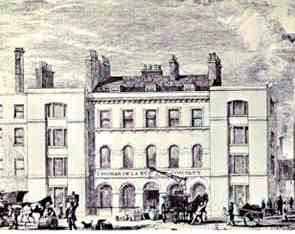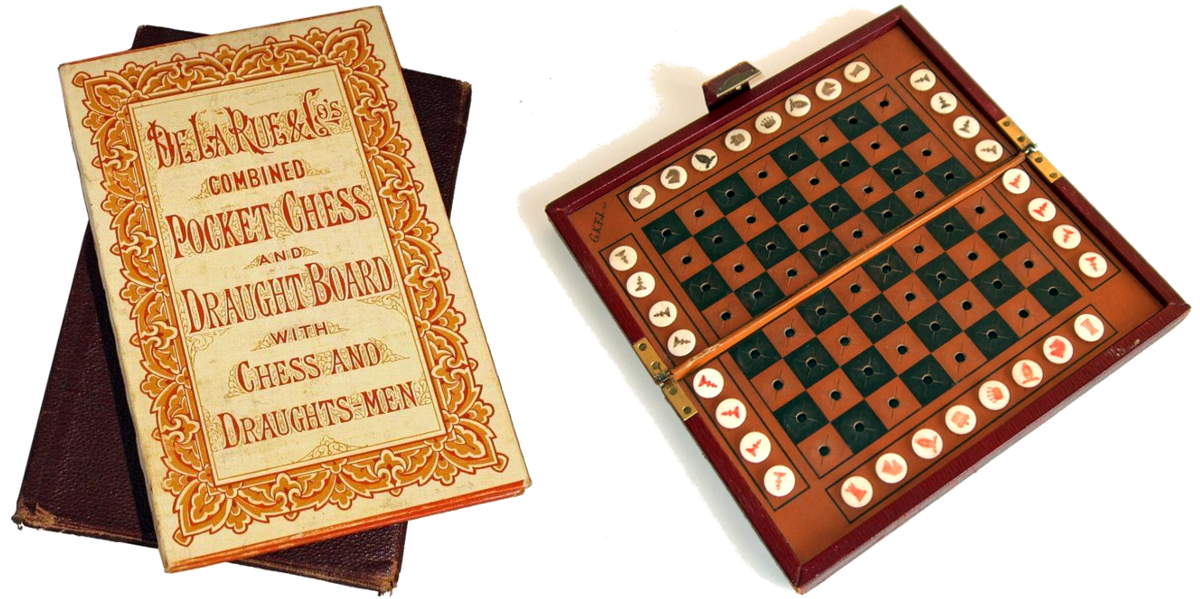Draughts League Medals
Arthur Charles Prince worked for De la Rue as a playing card cutter and later was promoted to supervisor of a small team of workers of same until his death aged 50.

De la Rue Draughts League Medals
Arthur Charles Prince worked for De la Rue from about the late 1880s until 1920. Arthur worked as a playing card cutter and later was promoted to supervisor of a small team of workers of same until his death aged 50. The medals below show that Arthur also enjoyed playing the game of draughts. Arthur Prince had lost his father when very young, and was living with his step-mother in Banner Street which formed a T-junction with Bunhill Row, where the offices were situated. He worked for the company all his life and was a very loyal employee. He was suffering from a bad cold and went back to work too soon and caught pneumonia and died.

Above: 2 medals (front and back) awarded to Arthur Charles Prince, who worked for De la Rue from about the late 1880s until 1920 and participated in the draughts league. The square medal is gold with his initials ACP engraved on the front, and the inscription "S.T.T.T. Draughts Handicap won by A.C. Prince June 1900". The other is silver with the inscription "L.P.T. Draughts League Winners 1907-08 De la Rue A.C.Prince". Images kindly supplied by Jenny Symien (née Prince).
The above photographs were kindly sent by Arthur C. Prince's grand-daughter Jenny Symien who also tells the following story:
“Both Arthur's sons were educated, my own father went to grammar school on a scholarship, trained as an accountant and after Army Service worked as Company Secretary for the Jaeger Company. All my generation of grandchildren of Arthur have had good schooling and/or university education and have had interesting professions. I see it as a small success story of a step out of poverty. We have much to thank Thomas de la Rue for!”
“Sadly not one photo of my grandfather. His father Hugh Prince was a horse hair dresser and his mother Martha was a book folder. Both could read and write and both died when he was quite young. His step-mother, Jane, whom his father married after Arthur's mother's death, brought him up. She worked as a silk winder. They came from Bethnal Green. He had a brother who trained as a shoeblack at the Central Shoeblack Society, Saffron Hill, and another who followed his father as a horse hair dresser. Both his brothers died in poverty in workhouse infirmaries, but Arthur Charles Prince made a good life for himself, his wife and four children by working at De la Rue, which offered him the opportunity for promotion. He started as a card cutter and ended as a supervisor of a small team of men. The family moved to Wood Green, north London. I don't know if he continued to work at Bunhill Row and travel. I am not sure if de la Rue had a place in north London.”
De la Rue were making pocket draught boards and pieces about the time Arthur C. Prince was working there and probably it sparked his interest.


By Simon Wintle
Member since February 01, 1996
I am the founder of The World of Playing Cards (est. 1996), a website dedicated to the history, artistry and cultural significance of playing cards and tarot. Over the years I have researched various areas of the subject, acquired and traded collections and contributed as a committee member of the IPCS and graphics editor of The Playing-Card journal. Having lived in Chile, England, Wales, and now Spain, these experiences have shaped my work and passion for playing cards. Amongst my achievements is producing a limited-edition replica of a 17th-century English pack using woodblocks and stencils—a labour of love. Today, the World of Playing Cards is a global collaborative project, with my son Adam serving as the technical driving force behind its development. His innovative efforts have helped shape the site into the thriving hub it is today. You are warmly invited to become a contributor and share your enthusiasm.
Related Articles

Scientific Whist
“Scientific Whist” : standard cards with instructions for play on the faces by Chas Goodall & Son, 1...

Agent Provocateur
Branded lingerie collection in a pack of pin-up playing cards.

Nimbus playing cards
Mike Steer’s weather-themed pack with suits in four colours and backs for cardistry.

Agatha Christie and Playing Cards revisited
Agatha Christie uses card-play as a primary focus of a story, and as a way of creating plots and mot...

The Decadent Deck
Studies in the eroticism of the female body by Inge Clayton.

Historic Shakespeare
“Historic Shakespeare” playing cards featuring Shakespearean characters by Chas Goodall & Son.

Copechat Paramount Sorting System
Preserving the past: a specimen deck showcasing edge-notched cards and their ingenious sorting syste...

Heartsette by Herbert Fitch & Co, 1893
A glimpse into a busy print and design office in late Victorian London.

Batman® playing cards
Batman playing cards published by InterCol of London 1989.

Can You Believe Your Eyes?
“Can You Believe Your Eyes?” playing cards featuring visual illusions & other oddities.

Pastime Playing Cards for the Blind
The “Pastime” Playing Cards for the Blind manufactured by Goodall & Son Limd., c.1910.

Songs with Flute accompaniment
Eighteenth century English engraved cards with music for voice and flute.

Love Tests
Vintage novelty “Love Test” cards of a slightly saucy nature but all in good fun!

Ben 10 playing cards
Characters from the American animated television science fantasy series Ben 10.

Doctor Who Trump Card Game
Game for two players in which Doctor Who and the Legendary Legion join battle with the Alien Hordes....

Disney’s Aladdin playing cards
Characters from the 1992 Disney film Aladdin.
Most Popular
Our top articles from the past 28 days

